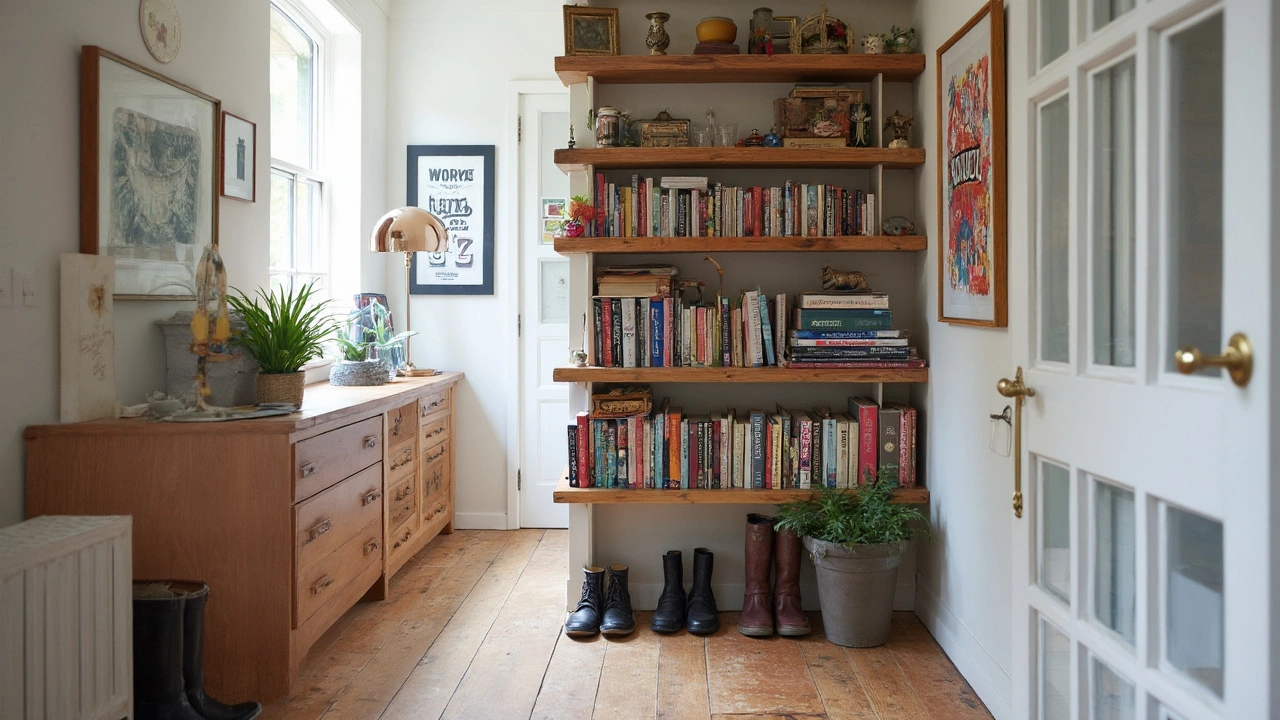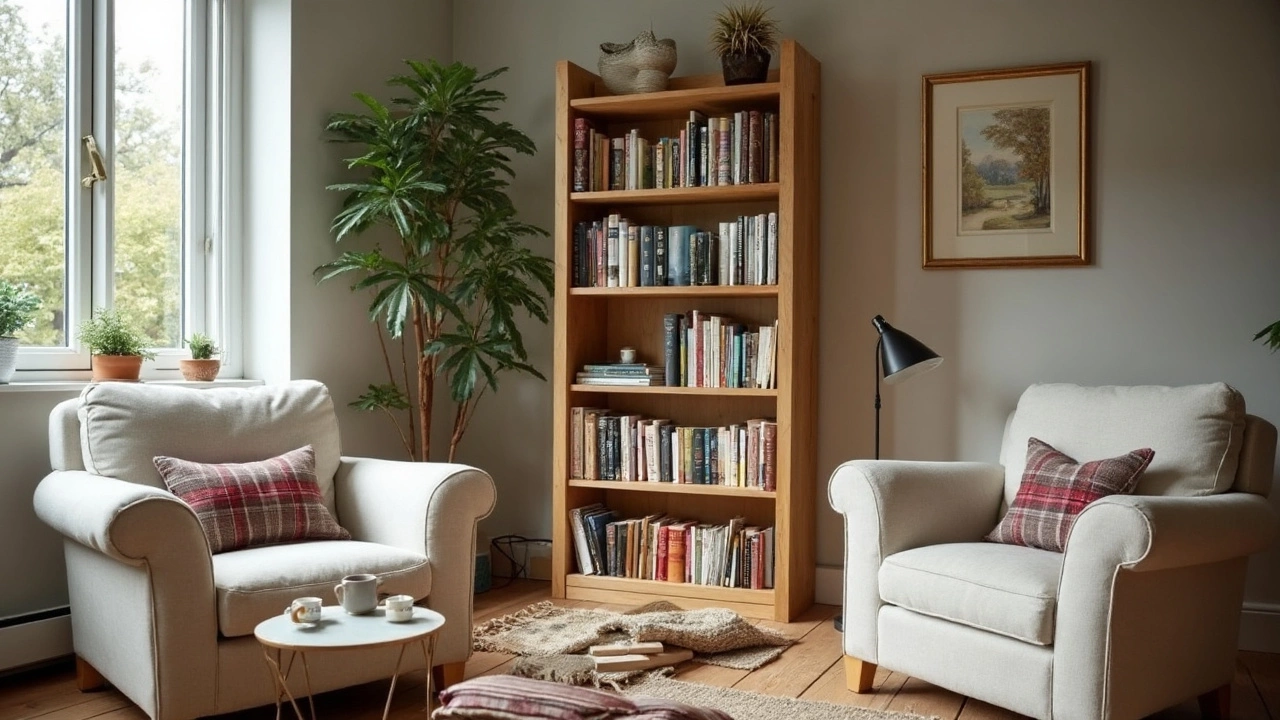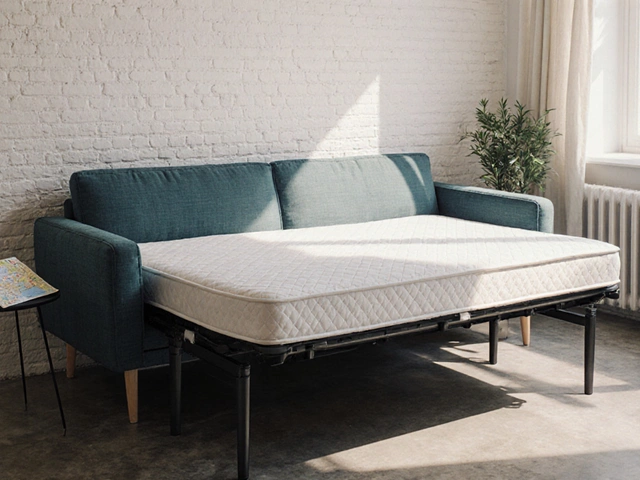Most people just shove a bookshelf against any empty wall and call it a day. But that’s basically leaving easy wins on the table. The spot you pick totally changes how your space feels, how easy it is to grab your favorite book, and even how long your books last.
Think about it: A bookshelf squeezed behind a door, or jammed between bulky furniture? It just turns into wasted real estate. But get the placement right, and suddenly your books become a feature, not just background clutter. And if you’re tight on space, the way you place your bookshelf might give you a little extra breathing room—or make your room feel like a cramped storage unit.
Here’s the first thing nobody tells you: books hate sunlight. Sun-faded covers and warped pages are a real thing. So when picking a spot, you want somewhere easy to reach, out of direct sun, and away from stuff that could mess up your book collection, like radiators or leaky windows. Start by looking around your main rooms for underused corners and blank walls—it’s surprising how one well-placed bookcase can pull a room together and actually make you want to read more.
- Understanding Your Space: What to Check First
- Living Room Choices: Make Books the Star
- Bedroom & Home Office: Boost Comfort and Focus
- Small Spaces and Odd Angles: Creative Solutions
- Unexpected Spots: Hallways, Nooks, and Beyond
- Practical Tips: Safety, Light, and Book Care
Understanding Your Space: What to Check First
Before you even start dragging that bookcase across the floor, check out what you’re working with. Every room has its own quirks—some good, some annoying. The goal: find a spot that fits your shelf and doesn’t mess up how you use the space.
Notice where the big stuff is placed. Beds, couches, and desks usually hog the main walls, so look at what’s left over. Corners and short walls might be goldmines for your bookshelf. And don’t just measure width—pay attention to height too. A tall shelf up for grabs? Double-check there’s no thermostat or weird light fixture in the way above it.
Moisture is another killer for books. Basements and laundry rooms might seem like logical dumping grounds, but those places can get damp and moldy fast. Books need a dry spot with steady temperature. According to the Library of Congress, books like temps between 60-70°F and humidity between 30-50%—way less than your average basement or steamy bathroom. Humidity freaks books out, causing warped pages and funky smells.
Sunlight makes a room look nice, but it’ll toast your book covers over time. Figure out how sun moves through each room at different times of the day. If you notice hard sun beams for hours, it’s better to stash your bookshelf a few feet away from that window or put up sheer curtains for extra protection.
| Thing to Check | Why It Matters | Best Range/Condition |
|---|---|---|
| Moisture | High humidity warps and damages books | 30-50% humidity |
| Temperature | Extreme cold/heat shortens book life | 60-70°F (16-21°C) |
| Sunlight | Direct sun fades covers, dries out glue | Indirect or diffused light |
| Empty Wall Space | Ensures bookshelf fits without blocking stuff | Minimum as wide and tall as your case |
Don’t forget outlets and vents. If a vent blasts hot or cold air right at your books, that’s a slow disaster. And if you plan to put anything like a lamp or charging station on the bookcase, you’ll want an outlet close by.
Bottom line: scan the whole room and get out your tape measure. The right location saves you headaches later and puts your books where you’ll actually use them.
Living Room Choices: Make Books the Star
The living room is usually the busiest spot in the house, so it makes sense to put your bookshelf placement front and center. Books in your living room don’t just collect dust—they tell guests about you, kickstart conversations, and can make your space feel warmer and more personal. So, how do you pick the right place?
Start by using empty walls that could use a little personality. If you have a boring spot behind your couch or an awkward stretch next to a window, those work great. Avoid putting the bookshelf on a wall that gets blasted by afternoon sun. Direct sunlight fades book covers faster than you might expect—one study found that printed paper discolors after roughly 200 hours of strong sunlight exposure.
If you have a big TV setup, try flanking it with narrow bookcases. This balances out the look and keeps your screen from feeling like the only thing anyone should focus on. And here’s a cool trick: lining a bookshelf up with your couch or other seating creates a cozy reading corner, even in a huge room.
Got kids? Keep some shelves low so little ones can reach. Use baskets or boxes on lower shelves for a quick-tidy option when company surprises you. And skip putting heavy or expensive books above arm’s reach—no one wants a hardcover dropped on their head.
Here’s a quick breakdown of popular living room bookshelf spots and their pros and cons:
| Spot | Pros | Cons |
|---|---|---|
| Behind couch | Uses dead space, stylish backdrop | Books can collect dust, harder to reach |
| Either side of TV | Balanced look, easy to access | Can block speakers or vents |
| Unused corner | Makes corner useful, less traffic | Needs good lighting |
| Next to window | Natural light for reading | Risk of sun damage to books |
Don’t forget stability! Anchor tall bookcases to the wall, especially if you have kids or pets. Manufacturers like IKEA actually include wall brackets now, thanks to all the tip-over accidents in recent years.
Last tip: If your living room is small, go vertical. Tall, narrow units hold more books and eat up less floor space. And glass doors on a bookshelf aren’t just for fancy library looks—they keep your books dust-free and are especially popular in homes with pets.
Bedroom & Home Office: Boost Comfort and Focus
If you’re putting a bookshelf in your bedroom or home office, you’ve got to think about more than just squeezing it in wherever there’s a gap. Where you place it will actually change how comfortable and focused you feel in those spaces.
In bedrooms, it helps to keep your bookshelf close to where you unwind—near the bed or a reading chair—so grabbing a book before sleep feels effortless. But if your bed faces direct sunlight in the morning, skip placing the shelf right there, unless you want your covers to look like they were left on the dashboard in July. And if you’re using your bookcase as a nightstand (a move that’s gotten super popular), make sure the shelf is deep enough for a lamp and alarm clock.
For home offices, here’s a wild fact: researchers found that just seeing bookshelves while you work can lower stress and boost creativity. Put the bookshelf within arm’s reach of your chair so you actually use your resources. If you do video calls, styling your shelves behind you instantly levels up your background (no more blank walls or that awkward plant). Lots of folks anchor theirs behind the desk or on a side wall; just keep it out of walkways so you’re not tripping over dropped binders.
If space is tight, vertical bookcases work better than wide ones. Look for ones that fit snugly between your desk and the wall or use that wasted spot behind a door. Corner shelves don't just look cool—they fit where normal shelves can’t.
| Room | Ideal Placement | Main Benefit |
|---|---|---|
| Bedroom | Next to the bed or in a cozy sitting area | Easy access for nighttime reading and relaxation |
| Home Office | Side or behind desk, within arm's reach | Better focus, quick access to reference books |
Avoid storing books in spots with big temperature swings—like right next to a heater or a window that fogs up every morning. And if you live somewhere humid, stick a moisture absorber on the shelf to keep your pages crisp.

Small Spaces and Odd Angles: Creative Solutions
If you live in a shoebox apartment, or your place is crammed with weird corners and slanted ceilings, putting up a bookshelf can feel impossible. But all it really takes is a different approach—some of the best tricks are actually meant for awkward spots. Built-ins, floating shelves, and vertical bookcases can turn wasted inches into serious storage.
Let’s get practical. Floor-to-ceiling units use less square footage but load up on vertical storage. Got a weird nook under the stairs or an awkward alcove by the front door? These places practically beg for custom shelves or skinny freestanding bookcases. Even the back of a door can hold slim, shallow shelves—search “back-of-door bookshelves” and you’ll see what I mean! If you’re short on floor space but your walls are pretty bare, floating wall-mounted shelves are a lifesaver and can even double as a place for plants or tchotchkes.
Don’t forget corners! L-shaped or triangular corner shelves snap right into those otherwise wasted spaces, especially in small bedrooms or hallways. Modular bookcases are another win: you can re-stack or re-shape them if you move or change your mind.
- Go vertical: Use tall, skinny shelves instead of wide ones.
- Try wall-mounts: Floating shelves keep the floor clear.
- Custom-fit: Measure awkward nooks and get shelves cut to size.
- Don’t ignore corners: Corner shelves eat up dead space without crowding the room.
- Look above and below: Over-door shelves and toe-kick (under cabinet) shelves almost always go unnoticed.
For people who rent, look for shelves that use tension rods or command strips to avoid damage. And for those who double up on space, combo furniture—like ottomans or benches with built-in storage—gives you a spot for books plus bonus seating.
One study on urban apartments showed that using vertical shelving bookcase setups increased storage by up to 30% compared to traditional wide bookcases at the same footprint. Check out the numbers:
| Shelving Style | Typical Storage Increase | Good For |
|---|---|---|
| Vertical/Tall Bookcase | +30% | Small rooms, tight spaces |
| Floating Shelves | +15% | Above desks, beds, doorways |
| Corner Units | +12% | Unused corners |
So next time you look at a cramped room or strange corner, don’t see a headache—see future storage. With the right shelf style, even the smallest or oddest areas will work for you.
Unexpected Spots: Hallways, Nooks, and Beyond
If you think you’re out of room for another bookcase, you probably just haven’t looked in the right spot. The best bookshelf placement can be somewhere you barely noticed—like a hallway, under the stairs, or that awkward little nook next to your kitchen.
Hallways aren’t just empty space or storage for coats. The average American hallway is about 3 to 4 feet wide, and all you need is 10 inches for a slim bookcase. That means you can line one side with books and still walk through without bumping your shoulder every time. Plus, guests actually browse your shelves as they pass by—turning your home’s ‘dead space’ into something people talk about.
Nooks and alcoves pop up everywhere, especially in older houses and apartments. You can grab those awkward corners beside doors, under low windows, or even next to your fridge. Floating shelves are perfect here; they fit where regular-sized bookcases just won’t. Even a two-shelf unit under a bay window can hold a surprising number of books (and doubles as a bench if you toss a cushion on top).
And if you’re living small, don’t forget spots like:
- Top of stairs – A bookcase here makes good use of landing space nobody sits in.
- Behind the couch – Low bookshelves double as both storage and a sofa table.
- Under beds or lofts – Rolling bins or mini-bookshelves hold books where there’d otherwise just be dust bunnies.
Here’s a quick look at how much book storage you can squeeze into those odd spaces:
| Spot | Typical Max Shelf Length | What Fits |
|---|---|---|
| Hallway (10-inch deep shelf) | 6 feet | About 75-90 paperbacks |
| Under window (2-shelf unit) | 4 feet | 40-50 paperbacks |
| Stair landing | 3 feet | 30-35 paperbacks |
| Floating shelves in nooks | Variable | Depends, but goes higher and wider than you’d expect |
When you’re measuring, leave a little breathing room on the shelf ends to actually pull books out. Anchor everything to the wall—no one wants to watch a shelf pancake from a hallway bump or a slammed door.
Practical Tips: Safety, Light, and Book Care
Let’s be real: the wrong spot for a bookshelf can bring up a whole bunch of annoying problems. Think wobbly shelves, sun-bleached pages, and book spines curling from heat or humidity. So before you slide that bookshelf placement app, let’s get you dialed in on the basics that matter most for safety, light, and keeping your books in top shape.
First up, safety. Any bookshelf taller than hip height needs to be anchored to the wall, especially if kids or pets roam your place. The U.S. Consumer Product Safety Commission warns that unstable bookcases tip over more than people think. That’s why almost every furniture store now includes a bracket and wall strap kit in the box.
- Always find a wall stud if possible. Drywall anchors aren’t enough for a heavy load of books.
- If you’ve got little ones, keep heavy or big books on the bottom shelves—hardcover encyclopedias on top are a recipe for a bump on the head.
- Whenever you move the bookshelf or add a lot more books, do a quick stability check. Wiggly shelves? Time to tighten up or reposition.
Light can be tricky. Sure, a sunny reading nook looks great for a photo, but direct sunlight ruins books fast. Pages get brittle, covers fade, and the whole collection loses its crisp look. According to the American Library Association, "Direct sunlight can reduce the lifespan of a book by half, even through glass windows."
"Store books in areas with indirect light and consistent temperatures. Books prefer cool, dry, and shaded environments." – American Library Association
So, avoid windowsills and spots where light lands for more than an hour a day. If you love to show off your library, add LED shelf lighting—these don’t emit UV rays, so no worries about fading.
A few more book-care tips nobody tells you: Stay clear of radiators, floor vents, and damp basements. Humidity causes mold and warped pages, while heat dries out glues and paper. And honestly, don’t jam your books so tight you have to wrestle one free. Give them a little space to breathe, and they’ll last way longer.
- Dust shelves and books every couple of weeks. Dust attracts bugs, and that’s a one-way ticket to chewed spines and pages.
- If you live in a humid climate, consider a mini dehumidifier in the room with your bookshelf.
- Keep drinks and plants off the shelf. One spill will wreck a whole row—and plants leak moisture even if you can't see it.
Set it up right the first time and your books will look and feel new for years. Making your shelf safe, sun-smart, and clean isn’t just good for your books—it’s good for your peace of mind.



